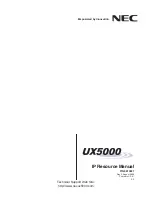
RTU-292 Operations Manual
automatic. The unit will continuously adapt to changing line conditions, making operation
insensitive to line impedance changes.
In the Automated Operations mode, the RTU-292 combines the unique features of its adaptive
DSP hybrid with fully unmanned auto-dial/auto-answer capability. In its standard
configuration, the unit uses tone prompts to signal the remote user of the operations that must
be performed to control the unmanned radio station. The addition of a Voice Prompt Option
supplies a large number of spoken prompts to simplify control. The Local Phone Option allows
a standard telephone set to be plugged into the rear panel of the RTU-292; this local phone may
then be used in place of the unit's keypad and handset.
Input and output levels are internally adjustable to accommodate all types of radio systems. A
set-up mode allows the adjustment of the RTU-292 receiver and transmitter signal levels
without any external test equipment.
The unit will interface all types of two-wire lines, such as normal dial-up lines, dedicated lines,
or twisted-pair field wire. Although the output impedance is fixed at 600 Ohms, the adaptive
hybrid in the unit will give excellent hybrid balance regardless of the impedance of the line
connected to the unit.
The unit operates from 115 or 230 VAC, 47 to 63 Hz, or from +12 or +24/+28 VDC nominal;
the +12VDC range extends from +11 to +15 VDC, while the +24/+28 VDC range extends from
+22 to +30 VDC. It is packaged in a rugged enclosure measuring 3.5"H x 19"W x 12"D. All
inputs and outputs, including those for power, are filtered or protected as appropriate to enable
the RTU-292 to meet the requirements of FCC Part 15 rules for a Class A Digital Device.
1.3 ASSEMBLIES
The standard RTU-292 contains five PC board assemblies; the main board (with plug-on
adaptive hybrid DSP board), three front panel switch PC board assemblies, and the Options
Interface Board, which is mounted in the Options Tray where other option boards may be
installed. Mounted on the front panel along with the switchboards are a speaker, control
potentiometers, phone jack and handset jack. The various I/O connectors and the DC power
input connector are accessible via the rear panel.
1.3.1 MAIN
BOARD
The main board has six general sections of circuitry: the Telephone Interface section,
Handset/Speaker Interface section, Radio Interface section, DSP section, CPU section, and
Power Supply section. These are described briefly in the following paragraphs. Refer to the
RTU-292 block diagram along with the text. (The power supply and DSP sections are not
shown in the block diagram, refer to Section 4 for more details.)
1.3.1.1 Telephone
Interface
The Telephone Interface Section has the amplifiers that drive and receive audio from the phone
line. This section also contains the DSP hybrid (which is detailed in Section 4 of this manual),
interfaced with the keypad. A tone ringer generates a warble audio tone when ring voltage is
received.
JPS Communications, Inc.
1-2
Summary of Contents for RTU-292
Page 10: ...RTU 292 Operations Manual This page intentionally left blank JPS Communications Inc 10 ...
Page 34: ...RTU 292 Operations Manual Figure 2 1 Outline Dimensions JPS Communications Inc 2 18 ...
Page 39: ...RTU 292 Operations Manual Figure 2 6 Interface Details JPS Communications Inc 2 23 ...
Page 112: ...RTU 292 Operations Manual Blank Page JPS Communications Inc 8 2 ...













































